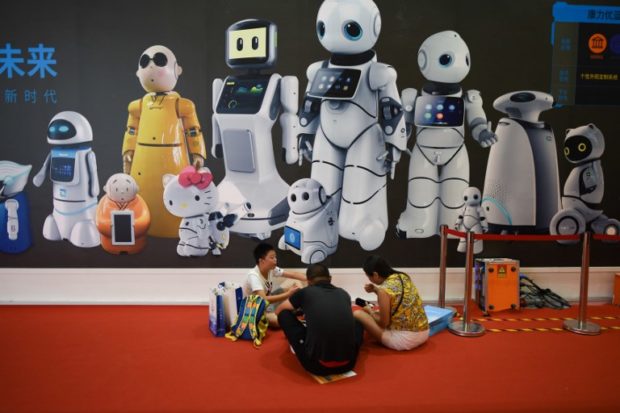
A family eats in front of a poster about robots at the 2018 World Robot Conference in Beijing on August 15, 2018. / AFP PHOTO / WANG Zhao
BEIJING—Robots that can diagnose diseases, play badminton and wow audiences with their musical skills are among the machines that China hopes could revolutionize its economy, with visitors to a Beijing exhibition offered a glimpse of an automated future.
The popular stars of this year’s World Robot Conference, which ended on Sunday, were undoubtedly the small, amateur-made “battle bots” which smashed, hammered and sawed their way through their opponents to a cacophony of cheers and shouts from a rapt audience.
“With this robot, I can fully express myself. I love the sparks,” said Huang Hongsong, one of around a dozen Chinese youths whose creations went head-to-head.
But while the battle bots are designed largely to entertain onlookers, China is deadly serious about riding the robotic wave with an eye on its economy.
Double whammy
Cheap manufacturing propelled the populous giant to become the world’s second largest economy in just a few decades.
But the country’s population is aging, leaving it facing a double whammy of a worker shortage and increased labor costs as it gets wealthier.
Automated machines offer a possible way out with President Xi Jinping in 2014 calling for a “robot revolution.”
Under the ruling Chinese Communist Party’s road map for its industrial future—dubbed “Made in China 2025”—state subsidies are pouring into the sector.
And at the robot show, a vast array of machines demonstrated how technology may eventually replace human workers.
In one corner, a mechanical arm—designed to teach children—painted an elegant Chinese character while a robotic fish explored its tank and a bat flapped its mechanical wings overhead.
Outside China’s factories, robots are becoming a more visible presence, deployed in restaurants and banks, and even delivering parcels.
Doctor Bot
China’s iFlytek, a specialist in speech recognition systems, presented a new “medical assistant” robot at the Beijing show which it said was able to help identify up to 150 diseases and ailments—even passing a national medical qualification exam with a high score.
The robot, which operated in conjunction with a doctor, asks patients a series of diagnostic questions and can also analyze X-rays.
“It’s already being used in hospitals since March and has made some 4,000 diagnoses,” company president Liu Qingfeng said, adding such a device could be particularly useful for clinics in more remote parts of China.
Chindex, a subsidiary of the conglomerate Fosun, also distributes the “da Vinci System” in China, an American-built robot with arms and high-tech cameras to aid surgeons in the operating theater.
“It transcends the limits of the (human) eye,” said chief operating officer Liu Yu.
But like the diagnostic robot, it still needs a helping human hand.
“It only helps the doctor, it cannot replace them. It would not be ethical, the human body is still too complicated,” he said.
Delicate balance
By 2020, China is aiming for half of the industrial robots sold in the country to be made by Chinese companies, up from 27 percent currently—with a target of 70 percent by 2025.
China is now the world’s No. 1 market for industrial robots with some 141,000 units sold last year, accounting for a third of global demand, according to the International Federation of Robotics, which says demand could rise an additional 20 percent per year until 2020.